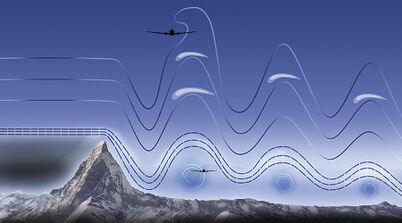Mountain Wave Turbulence
Jump to navigation
Jump to search

Introduction[edit | edit source]
Mountain wave turbulence is a type of atmospheric turbulence that occurs when strong winds encounter a mountain range, forcing the air to rise and creating wave-like patterns that can cause strong up and downdrafts, potentially leading to severe turbulence for aircraft.
Formation[edit | edit source]
- Wind Flow: Mountain waves form when strong winds flow perpendicularly (or nearly so) to a mountain range.
- Air Lifting: The wind is forced to rise over the mountain, and as it ascends, it cools and may encounter a stable layer of air, leading to the formation of waves.
- Wave Patterns: These waves can extend horizontally and vertically, creating areas of both upward and downward air currents.
Conditions[edit | edit source]
Mountain waves are most likely to occur when:
- Winds are strong and blowing across a mountain range.
- There is a stable layer of air above the mountain.
- Wind speed increases with altitude.
Types[edit | edit source]
There are two main types of mountain waves:
- Trapped lee waves: These waves are trapped near the mountain and can extend hundreds of miles downwind.
- Vertically propagating waves: These waves can extend high into the atmosphere.
Effects on Aviation[edit | edit source]
- Turbulence: Mountain waves can create strong updrafts and downdrafts, leading to turbulence that can be hazardous for aircraft.
- Altitude Changes: Aircraft can experience rapid changes in altitude as they encounter the waves, making it difficult to maintain altitude.
- Airspeed Changes: The turbulence can also cause changes in airspeed, requiring pilots to make frequent corrections.
- Rotor Clouds: Below the crests of the waves, rotor clouds can form, which are areas of intense turbulence.
- Lenticular Clouds: Lenticular clouds, which are lens-shaped clouds, can also be associated with mountain waves.
- Downslope Windstorms: Mountain waves can also contribute to downslope windstorms like chinooks.